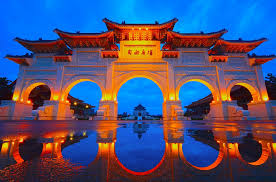24 May 2018
The Beautiful Island
Taiwan and Beijing.
By Neil Tidmarsh
 Two weeks ago, I saw the Cloud Gate Dance Theatre perform their new production, Formosa, at Sadlers Wells.
Two weeks ago, I saw the Cloud Gate Dance Theatre perform their new production, Formosa, at Sadlers Wells.
At least, I think I did. I’m not so sure now.
Cloud Gate is a contemporary dance company from Taiwan. Taiwan is, of course, an island in the North Pacific Ocean some two or three hundred kilometres off the Chinese mainland; it was called Ilha Formosa – ‘the beautiful island’ – by Portuguese explorers in the sixteenth century. “Through dance, music, and spoken word” writes Sadlers Wells’ artistic director in the programme notes for Formosa, Cloud Gate “paints a striking portrait of Taiwan, its beauty, history and people”.
And indeed the work was beautiful and striking. So beautiful and so striking, in fact, that I wanted to jump onto an aeroplane to Taiwan straight away. And that’s the problem.
A few days ago, British Airways decided that Taiwan – a self-governing country not much smaller than the Republic of Ireland and with a population of twenty-four million – doesn’t exist and has never existed. And if Taiwan doesn’t exist, then I couldn’t have seen a dance company from Taiwan celebrate its existence, could I? Was it just a fantasy, then? Did I simply imagine it?
Taiwan has been self-governing since the end of the Chinese Civil War in 1949; Mao Zedong and the victorious Communists took over mainland China, and Chiang Kai-shek and the defeated Nationalists withdrew to Formosa/Taiwan. It’s now a multi-party democracy. Its main language is Mandarin, its currency is the Taiwan dollar, its people are well-educated and enjoy a high standard of living, it’s self-sufficient in food thanks to its agriculture and fisheries, its high-tech electronics industries are highly developed and its economy thrives through trade in global markets.
The Chinese government, however, doesn’t recognise Taiwan as an independent state. It insists that the island is a province of China. In recent months, the Chinese army and navy have been undertaking military exercises in the straits separating the island from the mainland; the operations have been supervised by President Xi in person, as if to emphasis that Beijing is ready and willing to impose sovereignty over the island, by force if necessary.
Beijing also insists that the rest of the world should consider Taiwan to be part of China, and is using diplomatic pressure on other countries and economic pressure on global businesses to isolate the island. Last month, Beijing told all foreign airlines to remove any reference to an independent Taiwan from their maps, websites and other publications; any airline which didn’t comply would be “discredited”. This week British Airways announced that it will indeed comply; none of its promotional material or mobile apps will in any way suggest that Taiwan is independent or self-governing, and as a destination the island will be referred to as ‘Taiwan-China’.
BA isn’t the only airline to comply, and it isn’t only airlines which have been under pressure from Beijing. Earlier this year the website of the US hotel chain JW Marriott was shut down when one of its surveys used source material which considered Taiwan to be an independent country. And last week, the US clothing retailer Gap was forced to apologise for producing a t-shirt with a map of China on it – which didn’t include the island of Taiwan. “We’ve learned that a Gap brand t-shirt failed to reflect the correct map of China. We sincerely apologise for this unintentional error” Gap said in a statement. “Gap Inc respects the sovereignty and integrity of China.”
Mind you, that weapon can cut both ways; another t-shirt with a map of China on it recently landed a party of fourteen Chinese tourists in trouble when they wore it on a holiday to Vietnam; police and border officials at Vietnam’s Cam Ranh International Airport ordered the tourists to change out of the t-shirts which they then confiscated, because the map printed on it claimed an area of the South China Seas as Chinese territory which is also claimed by Vietnam.
And remember the chocolate map on the pudding served at the banquet during the recent Korean peace summit where the North’s Kim Jong-un met the South’s President Moon?
The traditional Korean pudding is known as the “Spring of the People” – a mango mousse with ice cream and flower petals – but here it was topped by a chocolate map of the Korean peninsula, and the map included the Dokdo Islets, a group of islands occupied by South Korea but claimed by Japan. Japan was already nervous about a North/South rapprochement and worried that it was being squeezed out of the peace-process (North Korea has always been a threat to Japan and South Korea has historic grievances against Japan), and this pudding seemed to confirm its fears. Japan’s foreign ministry protested to the South Korean embassy in Tokyo, and the Japanese government asked for the desserts not to be served.
So – was it served, or not? Does anyone know? Kim Jong-un famously enjoys his food – he’s a gourmet who employs the very best chefs – so cancelling the pudding would have been a very dangerous move indeed. So I would guess that it was in fact served. After all, if it hadn’t been, an annoyed and hungry Kim Jong-un would surely have changed his tune about the peace process by now, surely he’d be threatening to call off next month’s meeting with President Trump or something…
Ah, well, now, perhaps that’s another mystery solved.


